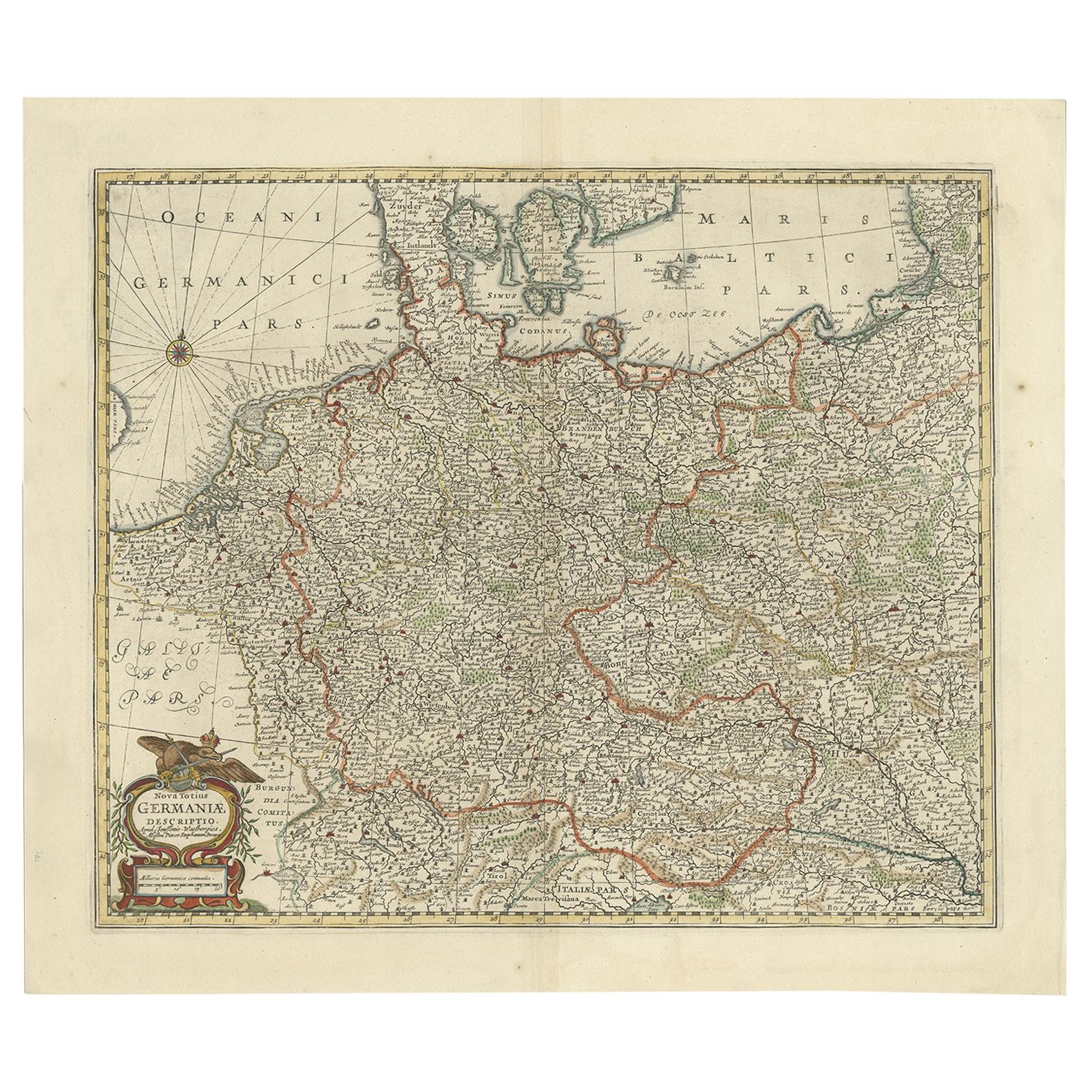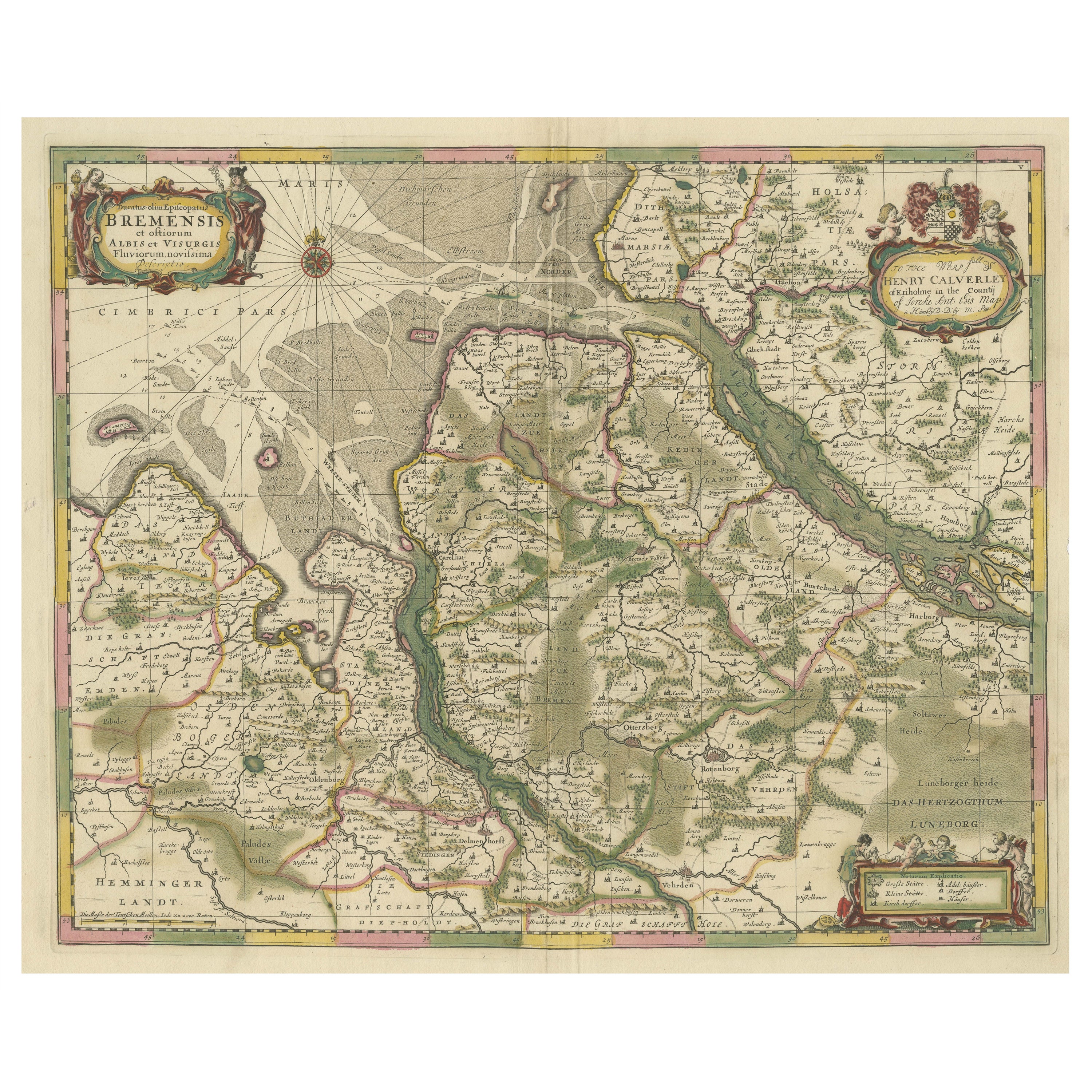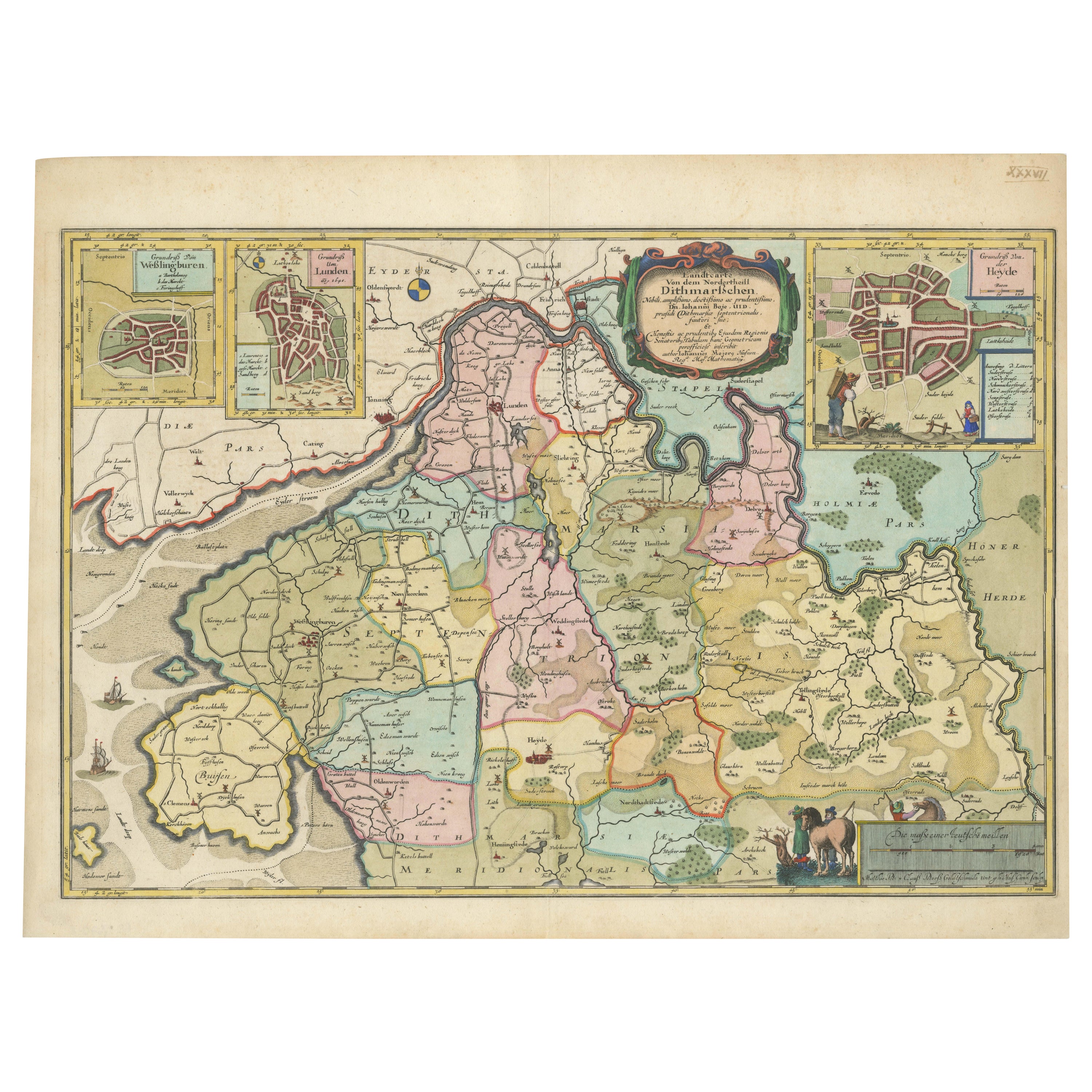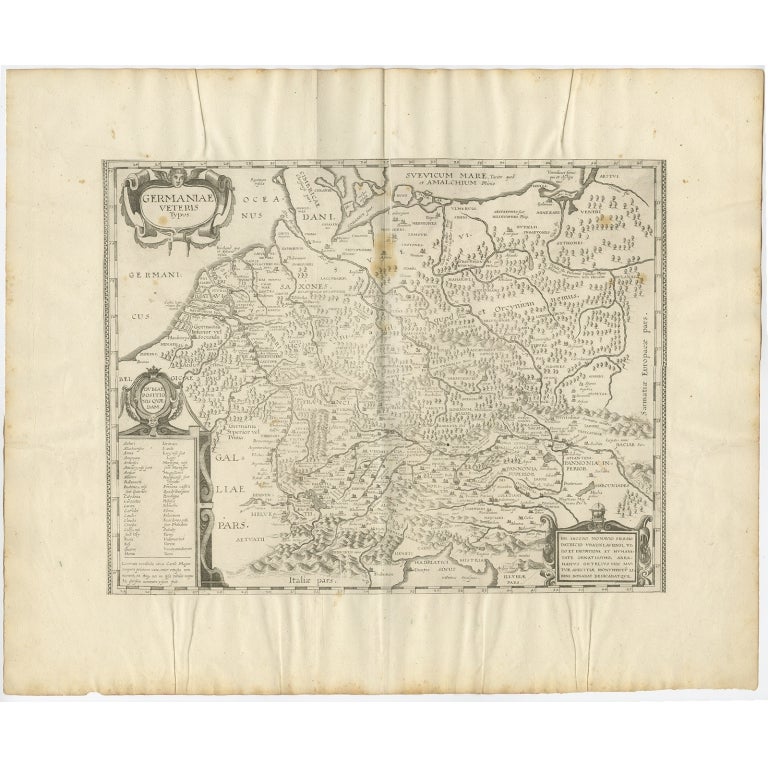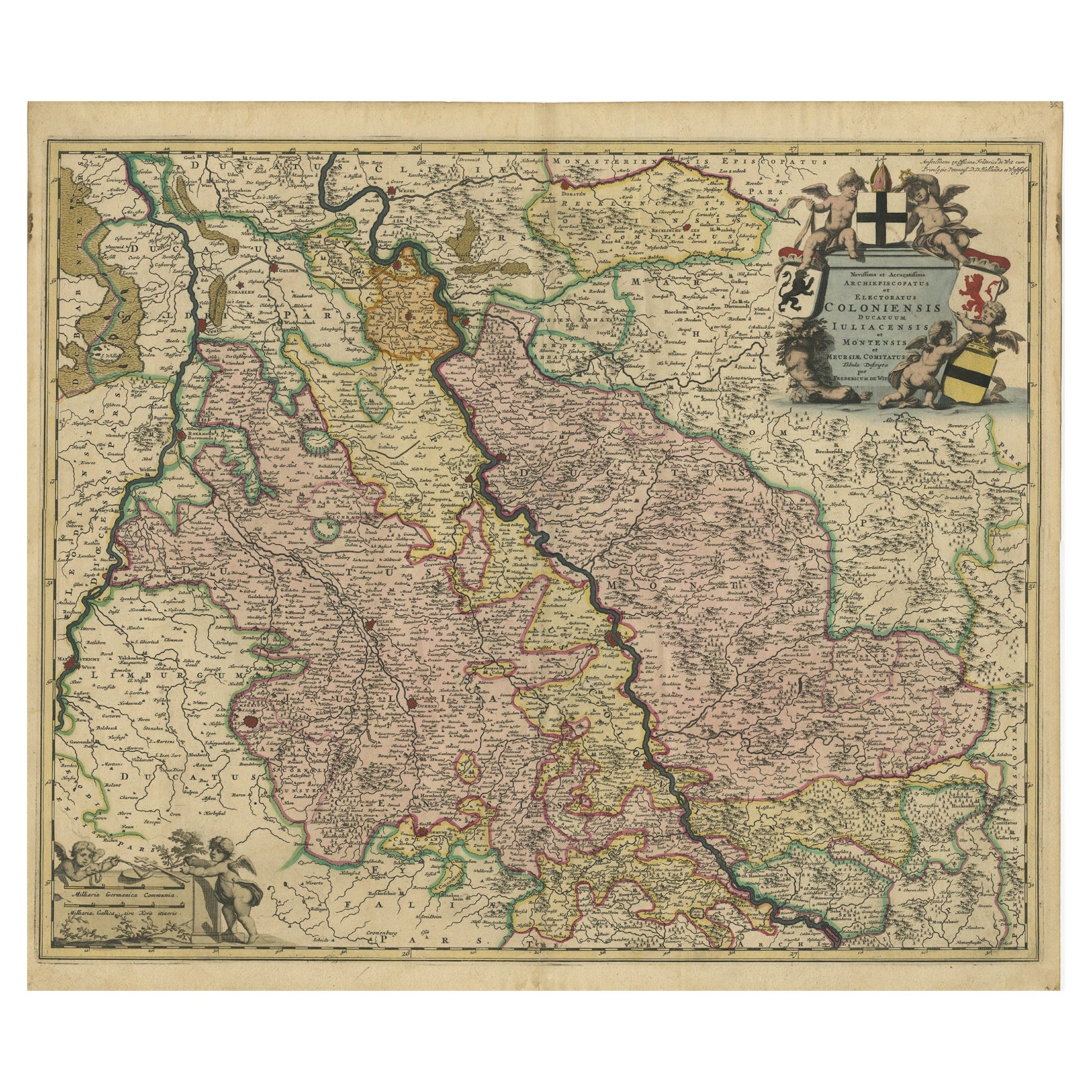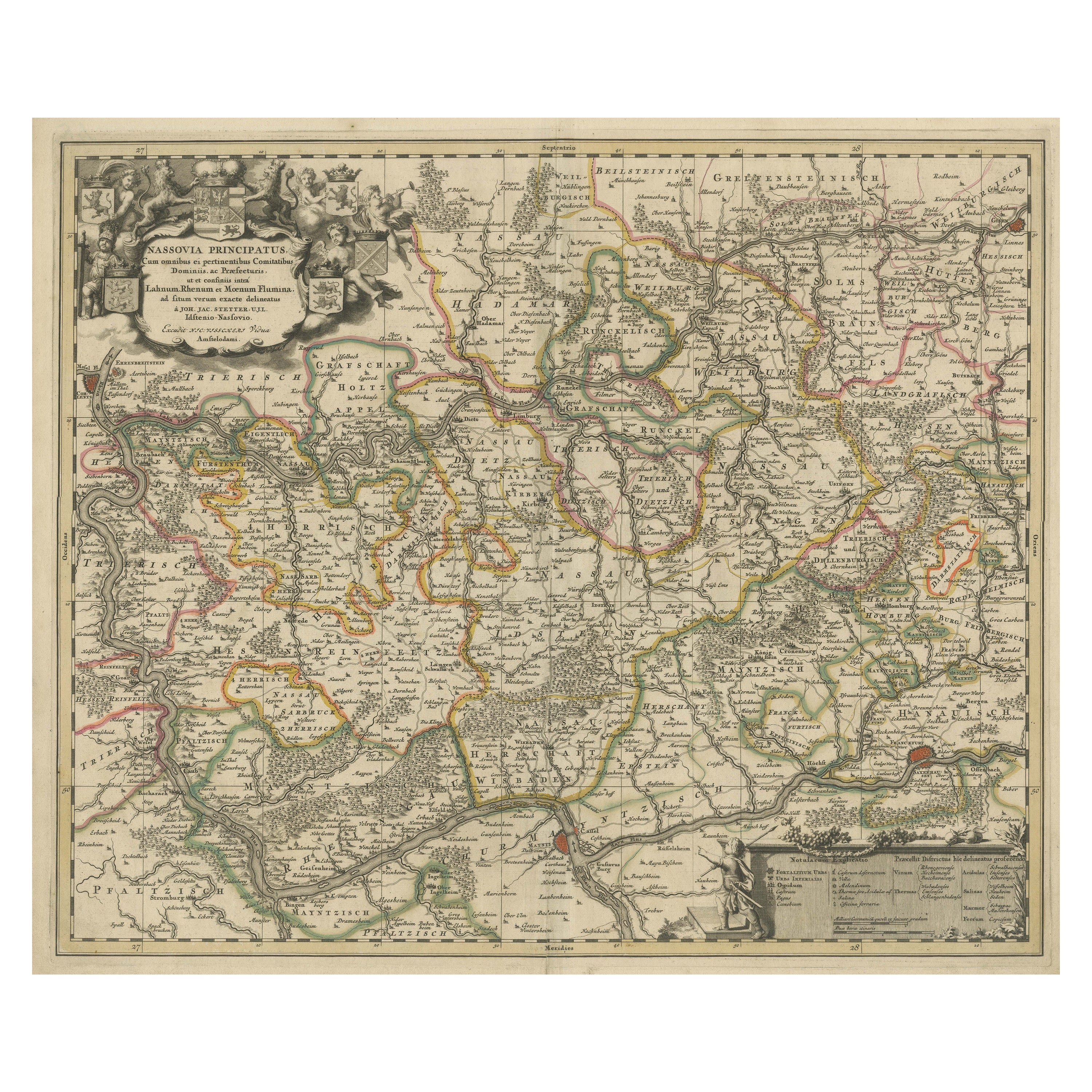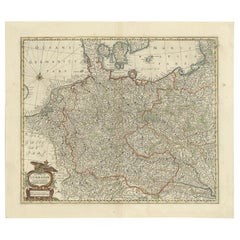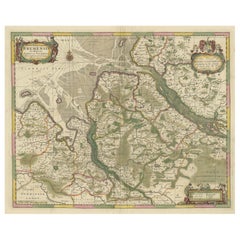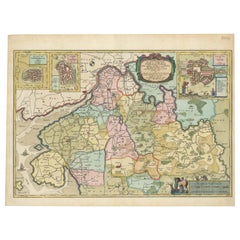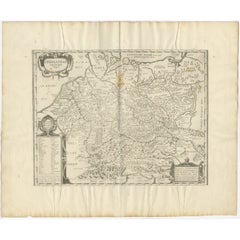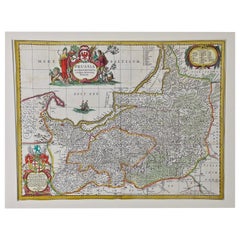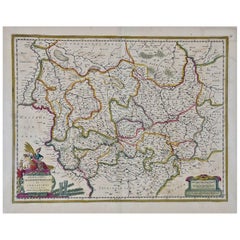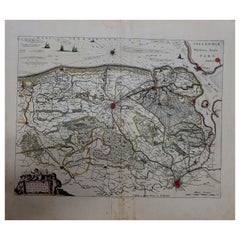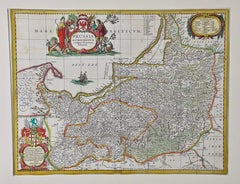Items Similar to Johannes Janssonius' 17th-Century Map of the Duchy of Bremen in Germany
Want more images or videos?
Request additional images or videos from the seller
1 of 9
Johannes Janssonius' 17th-Century Map of the Duchy of Bremen in Germany
$738.06
$922.5720% Off
£549.44
£686.7920% Off
€616
€77020% Off
CA$1,010.95
CA$1,263.6920% Off
A$1,124.40
A$1,405.5020% Off
CHF 587.13
CHF 733.9120% Off
MX$13,682.75
MX$17,103.4420% Off
NOK 7,498.51
NOK 9,373.1320% Off
SEK 7,032.28
SEK 8,790.3420% Off
DKK 4,689.39
DKK 5,861.7420% Off
Shipping
Retrieving quote...The 1stDibs Promise:
Authenticity Guarantee,
Money-Back Guarantee,
24-Hour Cancellation
About the Item
The map titled "Ducatus olim Episcopatus Bremensis et ostiorum Albis et Visurgis Fluviorum novissima Descriptio" by Johannes Janssonius provides a rich historical and geographical illustration of the Duchy of Bremen area during the 17th century.
Geographic Coverage:
- Geographical Detail: The map covers the area between the Elbe and Weser rivers, including the strategic river mouths essential for trade and navigation. It extends from the island of Wangeroog to Cloppenburg and Verden, encompassing a significant portion of what is now Lower Saxony, Germany.
- Cities and Towns: The map is densely populated with names of cities, towns, and smaller settlements, meticulously plotted. It provides a detailed view of the urban landscape during the period, highlighting important centers like Bremen, the duchy's capital Stade, and other significant towns like Verden and Cloppenburg.
Artistic Elements
- Cartouches: The map features beautifully decorated cartouches. The title cartouche in the top left is elaborate, providing historical context about the map's area and its significance. The top right houses a dedication cartouche, honoring Cornelius de Graaf of Amsterdam, adorned with an uncolored coat of arms held by putti, adding a noble flair.
- Compass Rose: Positioned in the North Sea, the compass rose is not just functional for orientation but also adds to the map’s aesthetic, emphasizing its nautical relevance.
- Mile Indicator: A practical and visually appealing mile indicator is located at the bottom left, scaled in Latin miles, which assists in understanding distances between various points on the map.
Historical Significance
- Temporal Context: The map depicts the Duchy of Bremen during its time under Swedish rule, following the Peace of Westphalia in 1648. This was a period of significant political realignment in Europe, especially in the Holy Roman Empire, of which the duchy was part.
- Purpose and Audience: Aimed at a scholarly or noble audience, the map serves both as a practical tool for understanding the geography and as a piece of political propaganda, illustrating the reach and governance of Swedish power in the Holy Roman Empire.
This map is a fascinating artifact, offering insights into the political, geographical, and cultural landscape of 17th-century northern Germany. It is a testament to the cartographic skill of Johannes Janssonius and a valuable piece for any collector interested in the cartography of the period or the historical dynamics of the region.
Johannes Janssonius was active as a cartographer during the early to mid-17th century. His major works were produced in the 1630s and 1640s.
Given that the Duchy of Bremen was formed in 1648 and this map depicts the region under Danish rule, it is likely that the map was produced sometime after 1648, possibly in the 1650s or later, when Janssonius was still active in producing maps.
The text in Latin on the map, "Ducatus olim Episcopatus Bremensis et ostiorum Albis et Visurgis Fluviorum novissima Descriptio", translates to "The latest description of the Duchy, formerly the Bishopric of Bremen, and the mouths of the Elbe and Weser Rivers" in English.
Description of the Text and Its Significance:
- Ducatus olim Episcopatus Bremensis: This refers to the area once known as the Bishopric of Bremen, which later became the Duchy of Bremen. The term "olim" signifies "formerly," indicating a historical change in status from a religious bishopric to a secular duchy.
- et ostiorum Albis et Visurgis Fluviorum: This part highlights the geographical features, specifically the estuaries ("ostiorum") of the Elbe ("Albis") and Weser ("Visurgis") Rivers. The focus on river mouths emphasizes the map’s utility in navigation and trade, significant for economic and military purposes.
- novissima Descriptio: This means "the latest description," suggesting that the map provides the most up-to-date cartographic information of its time.
The detailed inclusion of geographical, administrative, and historical elements in the text complements the visual detail of the map, providing viewers with a comprehensive understanding of the region’s importance during the 17th century. Such maps were crucial for navigation, trade, and asserting territorial claims, making this map a valuable resource for contemporary users and a historical artifact for collectors today.
Important Cities or Areas on the Map
1. Bremen: As the primary city of the Duchy of Bremen, it would be a central focus for map collectors. Bremen has been a major port and trading center, rich in Hanseatic League history.
2. Stade: Mentioned as the capital of the Duchy of Bremen post-1648. Stade held significant strategic and administrative importance during the time this map represents.
3. Hamburg: Although just outside the duchy, Hamburg is close enough to be of interest due to its major role in trade and as a Hanseatic city.
4. Verden: Another significant city in the region, Verden was part of the Bishopric that formed the Duchy with Bremen.
5. The Elbe and Weser Rivers: These rivers are crucial for their role in navigation and trade, making any regions along these waterways significant.
6. Cloppenburg and Wangeroog: Smaller towns and areas like these add local detail and interest for collectors, particularly those focusing on comprehensive regional mapping.
Historical Context Around 1650 in the Duchy of Bremen
During the mid-17th century, the Duchy of Bremen was experiencing significant changes. Here are some key points:
- Thirty Years' War (1618-1648): This devastating conflict affected much of Europe, including the Holy Roman Empire, of which the Duchy of Bremen was a part. The war had significant impacts on trade, population, and the overall economy.
- Peace of Westphalia (1648): This crucial treaty ended the Thirty Years' War and redefined many territorial boundaries. The Duchy of Bremen was formally established as a secular duchy after being a bishopric, indicating a shift from ecclesiastical to secular governance. It was awarded to Sweden, marking the start of Swedish rule.
- Swedish Rule: Post-1648, under Swedish governance, the Duchy of Bremen was managed as part of the Swedish Empire's territories within the Holy Roman Empire. This period was marked by administrative reforms and integration into Swedish imperial structures.
- Economic Recovery and Development: Following the ravages of the Thirty Years' War, the region would have been undergoing recovery and attempts at economic stabilization and growth, particularly through trade via the Elbe and Weser rivers.
For collectors or historians interested in this period, maps like the one produced by Janssonius serve not only as geographical records but also as historical documents that capture a snapshot of the political and cultural landscape during a transformative period in European history.
- Dimensions:Height: 18.51 in (47 cm)Width: 22.45 in (57 cm)Depth: 0 in (0.02 mm)
- Materials and Techniques:Paper,Engraved
- Period:1650-1659
- Date of Manufacture:Circa 1650
- Condition:Condition: Good, given age. Vivid colors. General age-related toning and/or occasional minor defects from handling. Some support of the folding line on the reverse and small remains of tape. Please study scan carefully.
- Seller Location:Langweer, NL
- Reference Number:Seller: BG-13672-21stDibs: LU3054341305552
About the Seller
5.0
Recognized Seller
These prestigious sellers are industry leaders and represent the highest echelon for item quality and design.
Platinum Seller
Premium sellers with a 4.7+ rating and 24-hour response times
Established in 2009
1stDibs seller since 2017
2,510 sales on 1stDibs
Typical response time: <1 hour
- ShippingRetrieving quote...Shipping from: Langweer, Netherlands
- Return Policy
Authenticity Guarantee
In the unlikely event there’s an issue with an item’s authenticity, contact us within 1 year for a full refund. DetailsMoney-Back Guarantee
If your item is not as described, is damaged in transit, or does not arrive, contact us within 7 days for a full refund. Details24-Hour Cancellation
You have a 24-hour grace period in which to reconsider your purchase, with no questions asked.Vetted Professional Sellers
Our world-class sellers must adhere to strict standards for service and quality, maintaining the integrity of our listings.Price-Match Guarantee
If you find that a seller listed the same item for a lower price elsewhere, we’ll match it.Trusted Global Delivery
Our best-in-class carrier network provides specialized shipping options worldwide, including custom delivery.More From This Seller
View AllAntique Map of the German Empire, Johannes Janssonius van Waesbergen, circa 1670
Located in Langweer, NL
Antique map titled 'Nova Totius Germaniae Descriptio'. Uncommon map of the German Empire including the Netherlands, Germany, Switzerland, Austria, Bohemia,...
Category
Antique Late 17th Century Maps
Materials
Paper
$670 Sale Price
20% Off
Original Antique Map of the Area of Bremen and Lower Saxony
By Johannes Janssonius
Located in Langweer, NL
Antique map titled 'Ducatus olim Episcopatus Bremensis et ostiorum Albis et Visurgis Fluviorum novissima Descriptio'. Original old map of the area of ??Bremen and Lower Saxony. Uncom...
Category
Antique Mid-17th Century Maps
Materials
Paper
$632 Sale Price
20% Off
The 17th Century Map of Northern Dithmarschen and Its Towns in Germany
Located in Langweer, NL
This is a detailed colored copperplate engraving depicting northern Dithmarschen, accompanied by town plans of Weßlingburen (now Wesselburen), Lunden, and Heyde (now Heide) at the to...
Category
Antique 1640s Maps
Materials
Paper
$1,092 Sale Price
20% Off
Antique Map of Germany of German in Roman Times, c.1660
Located in Langweer, NL
Antique map Germany titled 'Germaniae Veteris Typus'. Antique map probably by Blaeu or based on an earlier state by W. Blaeu.
Minor differences shown in the cartouches. Top left ha...
Category
Antique 17th Century Maps
Materials
Paper
$814 Sale Price
20% Off
Rhine Splendor: Antique Map of the Lower Rhine Region, circa 1680
Located in Langweer, NL
The antique map titled 'Novissima et Accuratissima Archiepiscopatus et Electoratus Coloniensis Ducatuum Iuliancensis et Montensis et Meursiae Comitatus' is a handsome and detailed ma...
Category
Antique 1680s Maps
Materials
Paper
$920 Sale Price
20% Off
Free Shipping
Antique Map of the Nassau Region in Western Germany
Located in Langweer, NL
Antique map titled 'Nassovia Principatus (..)'. Detailed map of the Nassau region in western Germany between Koblenz, Hadamar, Giessen, Frankfurt and Mainz. The map is filled with in...
Category
Antique Early 18th Century Maps
Materials
Paper
$632 Sale Price
20% Off
You May Also Like
Prussia, Poland, N. Germany, Etc: A Hand-colored 17th Century Map by Janssonius
By Johannes Janssonius
Located in Alamo, CA
This is an attractive hand-colored copperplate engraved 17th century map of Prussia entitled "Prussia Accurate Descripta a Gasparo Henneberg Erlichensi", published in Amsterdam by Joannes Janssonius in 1664. This very detailed map from the golden age of Dutch cartography includes present-day Poland, Latvia, Lithuania, Estonia and portions of Germany. This highly detailed map is embellished by three ornate pink, red, mint green and gold...
Category
Antique Mid-17th Century Dutch Maps
Materials
Paper
17th Century Hand-Colored Map of a Region in West Germany by Janssonius
By Johannes Janssonius
Located in Alamo, CA
This attractive highly detailed 17th century original hand-colored map is entitled "Archiepiscopatus Maghdeburgensis et Anhaltinus Ducatus cum terris adjacentibus". It was published ...
Category
Antique Mid-17th Century Dutch Maps
Materials
Paper
1643 Willem&Joan Blaeu Map NW Flanders "Flandriae Teutonicae Pars Prientalior
Located in Norton, MA
1643 Willem and Joan Blaeu map of northwest Flanders, entitled
"Flandriae Teutonicae Pars Prientalior,"
Ric0012
" Authentic" - Map of the northwest Fl...
Category
Antique 17th Century Dutch Maps
Materials
Paper
A Hand Colored 17th Century Janssonius Map of Prussia: Poland, N. Germany, etc.
By Johannes Janssonius
Located in Alamo, CA
An attractive hand-colored copperplate engraved 17th century map of Prussia entitled "Prussia Accurate Descripta a Gasparo Henneberg Erlichensi", published in Amsterdam by Joannes Janssonius in 1664. This very detailed map from the golden age of Dutch cartography includes present-day Poland, Latvia, Lithuania, Estonia and portions of Germany. This highly detailed map is embellished by three ornate pink, red, mint green and gold...
Category
Mid-17th Century Old Masters Landscape Prints
Materials
Engraving
18th Century Hand-Colored Homann Map of Germany, Including Frankfurt and Berlin
By Johann Baptist Homann
Located in Alamo, CA
An 18th century hand-colored map entitled "Tabula Marchionatus Brandenburgici et Ducatus Pomeraniae quae sunt Pars Septentrionalis Circuli Saxoniae Superioris" by Johann Baptist Homa...
Category
Antique Early 18th Century German Maps
Materials
Paper
West Germany: Original Hand Colored 17th Century Map by Johannes Janssonius
By Johannes Janssonius
Located in Alamo, CA
An original hand colored copperplate engraved map entitled in Latin "Archiepiscopatus Maghdeburgensis et Anhaltinus Ducatus cum terris adjacentibus", published in Amsterdam in 1640 i...
Category
Mid-17th Century Old Masters More Prints
Materials
Engraving
More Ways To Browse
17th Century German
Imperial German
English Early 17th Century Furniture
Swedish 17th Century Furniture
17th Century Danish
Small Antique Compass
Antique Nautical Tools
Military Compass
Bremen Town Key
Tables With Inlaid Wood
World War Table
Antonio Jacobsen
Ariston Chairs
Coffee Tables Europe
Marble Top Dining Tables
Nordiska Argentina
Pink And Black Rug
Black Wooden Chair
